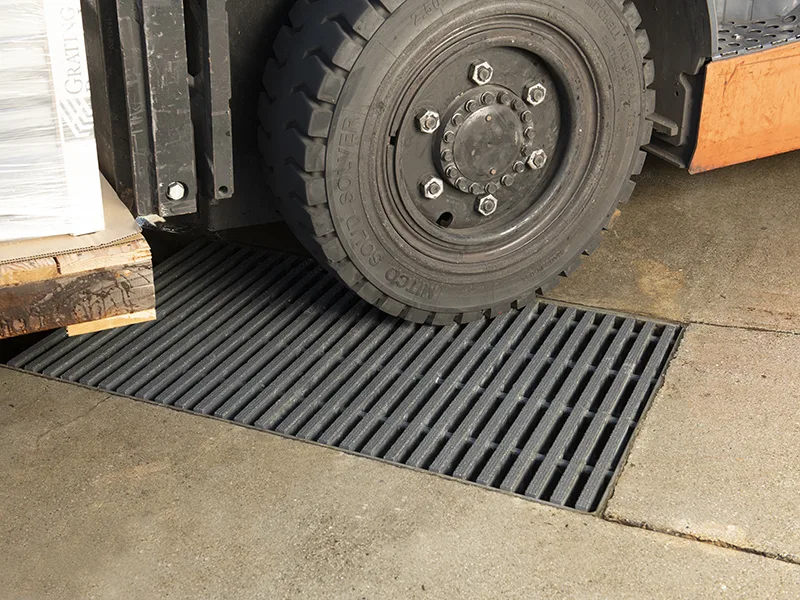Introduction
Industrial plants everywhere are under pressure to keep people safe, slash downtime, and rein in lifecycle costs. Walkways, trenches, and mezzanines that once relied on steel bar grating are now failing under heavier traffic, corrosive wash-downs, and stricter safety audits. That shift has many engineers asking a simple question: Is high load fiberglass grating the right upgrade for my plant?
High load fiberglass grating (HLFG) is a pultruded, fiberglass-reinforced polymer (FRP) panel designed to carry wheel loads of 500 kg and above without permanent deflection. Because the bars are molded or pultruded as a single composite, HLFG resists corrosion, is electrically non-conductive, and weighs roughly one-quarter of steel. This article lays out a decision framework—load, environment, economics, and compliance—so you can make a data-driven call.

high load fiberglass grating
Determining Your Plant’s Load & Environment Requirements
Clarify “High Load” Standards
The term high load is not marketing fluff; it is codified in ASTM F3059 and ANSI/NAAMM MBG-531, which require pultruded FRP panels to sustain a 1.4 kN/m² uniform load or a 5.6 kN point load with an L/200 deflection limit. Ask every supplier for third-party test reports and make sure the span in the lab matches your intended span in the field.
Environmental Stressors to Consider
Load tables only tell half the story. If your platform sees:
5 % sulfuric acid spray
UV exposure of > 1 200 MJ/m²-yr
Temperature swings from −40 °C to 80 °C
then bar sections should be specified with a premium vinyl-ester resin and UV inhibitors. The U.S. Chemical Safety Board estimates corrosion-related shutdowns cost refineries $7 billion each year—a reminder that material compatibility is not optional.
Who Gains the Most from High Load Fiberglass Grating?
Heavy Traffic, Heavy Industry
Facilities that roll forklifts, pallet jacks, or 2-ton skid steers across access ways—power utilities, wastewater treatment plants, pulp & paper mills, and shipyards—see the fastest payback. A Florida wastewater facility reported zero cracked panels after 120 000 forklift passes, compared with welded steel grating that needed patching every quarter.
Safety-Critical, Corrosive, or Electrically Sensitive Sites
Battery plants, food processors, and paint lines value HLFG for its dielectric strength (> 100 kV/in) and low flame-spread index (≤ 25). According to OSHA, slip-and-fall incidents account for 15 % of all accidental deaths in industry; the molded grit surface of HLFG raises the wet-slip resistance coefficient to 0.79, far above the 0.50 minimum many corporate safety policies require.
Performance Comparison: High Load FRP vs. Steel & Aluminum
Load Capacity & Safety Factor
At a 1.2 m span, a 51 mm deep HLFG panel rated HD25 deflects 3 mm under a 5.6 kN wheel load, while a 38 mm steel bar grating panel deflects 5 mm—66 % more—and begins corroding after three months of salt-spray. Built-in safety factors of 4 : 1 allow HLFG to maintain integrity even when seismic events or rogue loads exceed design values.
Lifetime Cost & Maintenance
A five-year total-cost study by an EPC contractor compared a 200 m² mezzanine in hydrochloric acid vapor:
| Material | CapEx (USD) | Annual upkeep | Total 5 yr |
|---|---|---|---|
| Painted steel grating | 28 000 | 4 500 | 50 500 |
| Aluminum | 34 000 | 2 800 | 48 000 |
| High load fiberglass grating | 42 000 | 600 | 45 000 |
Even though HLFG cost 15 % more up front, it delivered the lowest TCO and eliminated three shutdowns for recoating.
Real-World Proof & Expert Perspectives
Case Study: Petro-Chemical Dock Platform
Chevron’s Pascagoula marine terminal replaced 245 m of corroded steel walkway with high load fiberglass grating in 2022. Slip claims dropped to zero, and unplanned maintenance hours fell by 30 %, creating an 18-month return on investment.
Quote from Senior Structural Engineer
“The dielectric and corrosion performance let us combine personnel and chemical containment decks into a single platform, trimming three weeks off the construction schedule,” says Maria Gonzales, P.E., who oversaw the retrofit.
Her firsthand account underscores how composite engineering reduces both risk and install time.
Implementation Roadmap & Engineering Support
Design & Customization Workflow
Load analysis – Provide axle loads, span, support spacing.
Resin & grit selection – Vinyl-ester vs polyester; fine, medium, or coarse surfacing.
Panel optimization – Our engineers model deflection and bearing bar thickness in ANSYS.
Fabrication drawings – Water-jet cutouts for pipe penetrations, labeled for plug-and-play install.
Transparent collaboration helps purchasers slash RFQ cycles by up to 40 %.
Installation & Compliance Checklist
Verify lift-in points and spreader bar rigging.
Confirm clearances meet OSHA 1910.29 for Stairways and Walkways.
Test grounding straps where static discharge control is required.
Document torque values on FRP-approved fasteners.
Following this checklist kept a Midwest fertilizer plant’s install crew on schedule despite −10 °C weather and 20 km/h winds.
Conclusion
High load fiberglass grating shines when loads are heavy, environments are aggressive, and downtime is costly. Map your plant’s mechanical demands, chemical exposures, and budget trajectory against the standards and case data above. If numbers line up, request a free finite-element load analysis and a turnkey quotation—your next shutdown could be the last time you fight rust on a platform.
 info@unicomposite.com
info@unicomposite.com


























